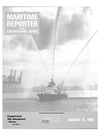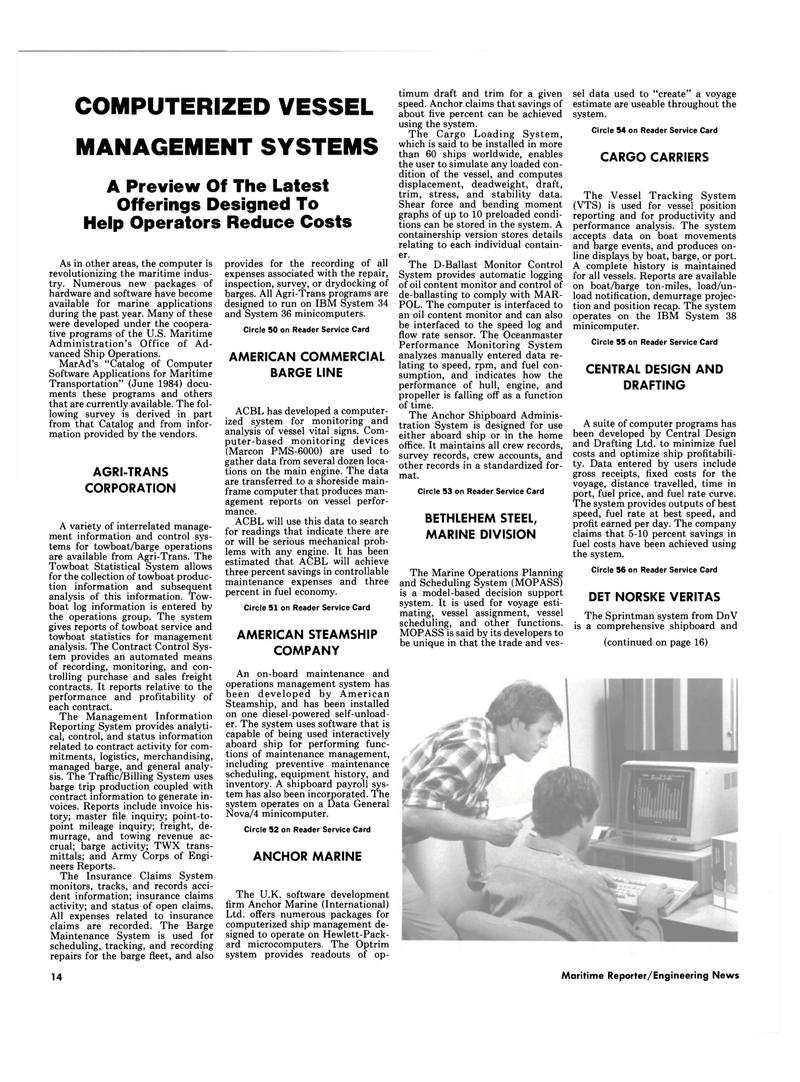
Page 12: of Maritime Reporter Magazine (January 15, 1985)
Read this page in Pdf, Flash or Html5 edition of January 15, 1985 Maritime Reporter Magazine
COMPUTERIZED VESSEL
MANAGEMENT SYSTEMS
A Preview Of The Latest
Offerings Designed To
Help Operators Reduce Costs
As in other areas, the computer is revolutionizing the maritime indus- try. Numerous new packages of hardware and software have become available for marine applications during the past year. Many of these were developed under the coopera- tive programs of the U.S. Maritime
Administration's Office of Ad- vanced Ship Operations.
MarAd's "Catalog of Computer
Software Applications for Maritime
Transportation" (June 1984) docu- ments these programs and others that are currently available. The fol- lowing survey is derived in part from that Catalog and from infor- mation provided by the vendors.
AGRI-TRANS
CORPORATION
A variety of interrelated manage- ment information and control sys- tems for towboat/barge operations are available from Agri-Trans. The
Towboat Statistical System allows for the collection of towboat produc- tion information and subsequent analysis of this information. Tow- boat log information is entered by the operations group. The system gives reports of towboat service and towboat statistics for management analysis. The Contract Control Sys- tem provides an automated means of recording, monitoring, and con- trolling purchase and sales freight contracts. It reports relative to the performance and profitability of each contract.
The Management Information
Reporting System provides analyti- cal, control, and status information related to contract activity for com- mitments, logistics, merchandising, managed barge, and general analy- sis. The Traffic/Billing System uses barge trip production coupled with contract information to generate in- voices. Reports include invoice his- tory; master file inquiry; point-to- point mileage inquiry; freight, de- murrage, and towing revenue ac- crual; barge activity; TWX trans- mittals; and Army Corps of Engi- neers Reports.
The Insurance Claims System monitors, tracks, and records acci- dent information; insurance claims activity; and status of open claims.
All expenses related to insurance claims are recorded. The Barge
Maintenance System is used for scheduling, tracking, and recording repairs for the barge fleet, and also provides for the recording of all expenses associated with the repair, inspection, survey, or drydocking of barges. All Agri-Trans programs are designed to run on IBM System 34 and System 36 minicomputers.
Circle 50 on Reader Service Card
AMERICAN COMMERCIAL
BARGE LINE
ACBL has developed a computer- ized system for monitoring and analysis of vessel vital signs. Com- puter-based monitoring devices (Marcon PMS-6000) are used to gather data from several dozen loca- tions on the main engine. The data are transferred to a shoreside main- frame computer that produces man- agement reports on vessel perfor- mance.
ACBL will use this data to search for readings that indicate there are or will be serious mechanical prob- lems with any engine. It has been estimated that ACBL will achieve three percent savings in controllable maintenance expenses and three percent in fuel economy.
Circle 51 on Reader Service Card
AMERICAN STEAMSHIP
COMPANY
An on-board maintenance and operations management system has been developed by American
Steamship, and has been installed on one diesel-powered self-unload- er. The system uses software that is capable of being used interactively aboard ship for performing func- tions of maintenance management, including preventive maintenance scheduling, equipment history, and inventory. A shipboard payroll sys- tem has also been incorporated. The system operates on a Data General
Nova/4 minicomputer.
Circle 52 on Reader Service Card
ANCHOR MARINE
The U.K. software development firm Anchor Marine (International)
Ltd. offers numerous packages for computerized ship management de- signed to operate on Hewlett-Pack- ard microcomputers. The Optrim system provides readouts of op- timum draft and trim for a given speed. Anchor claims that savings of about five percent can be achieved using the system.
The Cargo Loading System, which is said to be installed in more than 60 ships worldwide, enables the user to simulate any loaded con- dition of the vessel, and computes displacement, deadweight, draft, trim, stress, and stability data.
Shear force and bending moment graphs of up to 10 preloaded condi- tions can be stored in the system. A containership version stores details relating to each individual contain- er.
The D-Ballast Monitor Control
System provides automatic logging of oil content monitor and control of de-ballasting to comply with MAR-
POL. The computer is interfaced to an oil content monitor and can also be interfaced to the speed log and flow rate sensor. The Oceanmaster
Performance Monitoring System analyzes manually entered data re- lating to speed, rpm, and fuel con- sumption, and indicates how the performance of hull, engine, and propeller is falling off as a function of time.
The Anchor Shipboard Adminis- tration System is designed for use either aboard ship or in the home office. It maintains all crew records, survey records, crew accounts, and other records in a standardized for- mat.
Circle 53 on Reader Service Card
BETHLEHEM STEEL,
MARINE DIVISION
The Marine Operations Planning and Scheduling System (MOPASS) is a model-based decision support system. It is used for voyage esti- mating, vessel assignment, vessel scheduling, and other functions.
MOPASS is said by its developers to be unique in that the trade and ves- sel data used to "create" a voyage estimate are useable throughout the system.
Circle 54 on Reader Service Card
CARGO CARRIERS
The Vessel Tracking System (VTS) is used for vessel position reporting and for productivity and performance analysis. The system accepts data on boat movements and barge events, and produces on- line displays by boat, barge, or port.
A complete history is maintained for all vessels. Reports are available on boat/barge ton-miles, load/un- load notification, demurrage projec- tion and position recap. The system operates on the IBM System 38 minicomputer.
Circle 55 on Reader Service Card
CENTRAL DESIGN AND
DRAFTING
A suite of computer programs has been developed by Central Design and Drafting Ltd. to minimize fuel costs and optimize ship profitabili- ty. Data entered by users include gross receipts, fixed costs for the voyage, distance travelled, time in port, fuel price, and fuel rate curve.
The system provides outputs of best speed, fuel rate at best speed, and profit earned per day. The company claims that 5-10 percent savings in fuel costs have been achieved using the system.
Circle 56 on Reader Service Card
DET NORSKE VERITAS
The Sprintman system from DnV is a comprehensive shipboard and (continued on page 16) 14 Maritime Reporter/Engineering News

 11
11

 13
13
